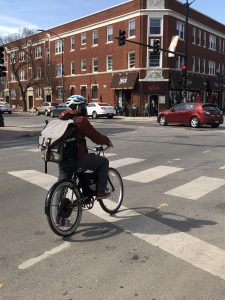Electric bicycles are booming in popularity, but their presence in Chicago’s bike lanes raises serious safety concerns. The bike injury lawyers of Zneimer & Zneimer P.C. have noted first had the increase of bike related injury victims that call our office.
E‑bikes can reach speeds up to 28 mph, significantly faster than most pedal bikes. Studies show:
- E‑bike riders suffer more severe injuries, including fractures, internal trauma, and concussions.
- One study published in Injury Prevention found 3x higher rates of pedestrian collisions and 17% internal injury rate for e‑bike riders versus just 7.5% for traditional bicyclists.
- U.S. emergency room visits for micromobility crashes rose 21% in 2022 alone. Between 2017 and 2022, at least 233 e‑bike fatalities were recorded.
Bike lanes were designed for slower, human-powered bikes. Mixing in high-speed e‑bikes without re-engineering the infrastructure can lead to more—and more serious—crashes.
What Chicago Law Says About E‑Bikes in Bike Lanes
Chicago distinguishes between different classes of e‑bikes. Under Chicago Municipal Code § 9‑40‑060(c):
“The rider of a Class 3 electric bicycle shall not ride in a bike lane.”
That means:
- Class 1 & 2 e‑bikes (which stop assisting at 20 mph) are allowed in bike lanes.
- Class 3 e‑bikes (which assist up to 28 mph) are prohibited from using bike lanes within the City of Chicago.
Further, under § 9‑52‑125, electric delivery bikes (common in gig work) must:
- Be registered and approved by the City;
- Not be operated or parked on sidewalks;
- Be operated in accordance with all bicycle laws.
The Hidden Dangers of Speed: Why Electric Bikes Increase Injury Risks for Riders
With the ability to reach speeds of 20 to 28 mph, these vehicles offer convenience and speed—but they also pose new dangers, especially for the riders themselves. Unlike traditional bicycles, e-bikes travel fast enough to outpace the expectations of both motorists and pedestrians, leading to an increase in certain types of collisions.
Dooring: A Split-Second Danger
One of the most type of bike cases that the bike injury lawyers of Zneimer & Zneimer P.C. handle are “dooring”—accidents, when someone opens a car door into the path of an oncoming bike. Chicago law prohibits this dangerous act. Under the Chicago Municipal Code § 9-80-035, it is illegal to open a vehicle door into moving traffic unless it is reasonably safe to do so and does not interfere with traffic, including bicycles.
But even with this law, the higher speed of e-bikes creates a visibility and timing problem. Someone exiting a car might glance in the side mirror and see nothing approaching—because an e-bike a block away can arrive in seconds. The result is often a violent crash with little or no time for the rider to react.
According to data from the Active Transportation Alliance, dooring accounted for more than 25% of all reported bike crashes in Chicago in some recent years. The problem is likely under-reported—and is now more dangerous than ever due to the rise of e-bikes.
The Right Hook: Misjudging Speed in the Bike Lane
Another scenario made worse by e-bike speed is the “right hook” crash. This occurs when a motorist makes a right turn across a bike lane, cutting off a cyclist traveling straight. Drivers often misjudge a cyclist’s speed—especially on an e-bike—leading them to initiate a turn thinking they have time. In reality, the e-bike is much closer than it seems.
Illinois law, under 625 ILCS 5/11-703(d), requires drivers to yield to a bicycle when turning right if the bike is in a bike lane or traveling in the same direction. However, the law can’t prevent a miscalculation caused by assuming all cyclists are traveling slowly.
Higher Speed, Higher Impact
Speed directly increases the severity of any crash. A rider thrown from an e-bike traveling at 25 mph will hit the ground with more than twice the kinetic energy of a traditional cyclist going 15 mph. That means more serious injuries—concussions, broken bones, and internal trauma.
Are E-Bikes Allowed in Chicago Bike Lanes?
Yes. According to Chicago Municipal Code § 9-52-020, electric bikes are classified similarly to regular bikes and are permitted to use bike lanes. However, the code does not distinguish between Class 1 (pedal-assist) and Class 2 or 3 (throttle-driven or higher-speed) e-bikes, raising questions about whether all types of e-bikes should be allowed in these lanes, especially given the risks to both riders and pedestrians.
Many bicycle accidents in Chicago result from cyclists not following the same traffic laws that apply to motor vehicles—especially when it comes to stop signs. While Illinois law requires bicyclists to obey all traffic signals and signs, including stop signs (625 ILCS 5/11-1503), some riders treat stop signs and traffic lights as optional and are only meant for motor vehicles. The danger is compounded when bike is electric and traveling at a high rate of speed. This behavior can confuse or endanger drivers and pedestrians who assume the cyclist will yield the right of way.
Failure to stop at stop signs or stop lights not only puts the cyclist at risk but can also complicate personal injury claims. If a bicyclist is injured in a crash after disregarding a stop sign or stop light, insurance companies may argue that the cyclist was at fault or contributed to the accident. The bike injury lawyers of Zneimer & Zneimer P.C. have handled a number of cases where the insurance companies have denied liability because a traffic video shows or an independent eye witness testifies that the bike rider went through the red light or didn’t stop at a stop sign.
 Chicago Accident Lawyer Blog
Chicago Accident Lawyer Blog



